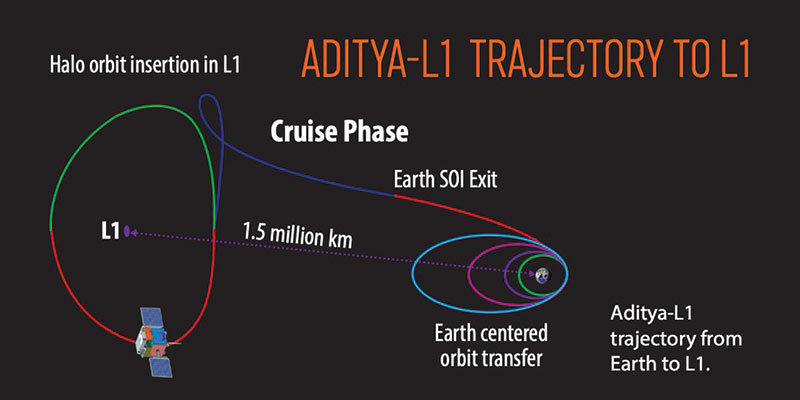- India
- Jan 08
Explainer - What are Lagrange Points?
• India’s first solar mission Aditya-L1 reached in a halo orbit around the L1 point, about 1.5 million kilometres from Earth from where it will orbit the Sun.
• The Lagrange point 1 (L1) of the Sun-Earth system is about one per cent of the total distance between the Earth and the Sun.
• The Halo-Orbit Insertion (HOI) of Aditya-L1 was accomplished on January 6.
• Halo orbit is that which moves around the L1 point with a size of six lakh km in one dimension, over two lakh km in another dimension and one lakh km in one more dimension, forming an egg-shaped orbit.
• A satellite in a halo orbit around the L1 point has the major advantage of continuously viewing the Sun without any occultations/ eclipses. This will provide a greater advantage in observing solar activities and their effect on space weather in real time.
• The final phase of the manoeuver involved firing of control engines for a short duration.
• A Polar Satellite Launch Vehicle (PSLV-C57) launched the Aditya-L1 spacecraft from the second launch pad of Satish Dhawan Space Centre (SDSC), Sriharikota, on September 2, 2023.
• Aditya-L1, weighing about 1,480.7 kg, is the first space-based Indian observatory to study the Sun.
• After a flight duration of 63 minutes and 20 seconds, it was successfully injected into an elliptical orbit around the Earth.
• It underwent a series of maneuvers thereafter and headed L1, having escaped the Earth's sphere of influence.
• Aditya-L1 will neither land on the Sun nor approach it any closer.
• The spacecraft carries seven payloads to observe the photosphere, chromosphere and the outermost layers of the Sun (the corona) using electromagnetic and article and magnetic field detectors.
• Using the special vantage point L1, four payloads directly view the Sun and the remaining three carry out in-situ studies of particles and fields at the Lagrange point L1, thus providing important scientific studies of the propagatory effect of solar dynamics in the interplanetary medium.
What are Lagrange Points?
• For a two body gravitational system, the Lagrange Points are the positions in space where a small object tends to stay, if put there. These points in space for two body systems such as Sun and Earth can be used by spacecraft to remain at these positions with reduced fuel consumption.
• At Lagrange Points, the gravitational pull of two large masses precisely equals the centripetal force required for a small object to move with them. These points in space can be used by spacecraft to reduce fuel consumption needed to remain in position.
• Lagrange Points are named in honour of Italian-French mathematician Joseph-Louis Lagrange.
• Of the five Lagrange points, three are unstable and two are stable. The unstable Lagrange points – labelled L1, L2, and L3 – lie along the line connecting the two large masses. The stable Lagrange points – labelled L4 and L5 – form the apex of two equilateral triangles that have the large masses at their vertices.
L1
The closer an object is to the Sun, the faster it will move. So, any spacecraft going around the Sun in an orbit smaller than Earth’s will soon overtake our planet. However, there is a loophole: if the spacecraft is placed directly between the Sun and Earth, Earth’s gravity pulls it in the opposite direction and cancels some of the Sun’s pull. With a weaker pull towards the Sun, the spacecraft needs less speed to maintain its orbit, so it can slow down. If the distance is just right – about a hundredth of the distance to the Sun – the spacecraft will travel slowly enough to keep its position between the Sun and the Earth. This is L1, and is a good position from which to monitor the Sun since the constant stream of particles from the Sun, the solar wind, reaches L1 about an hour before reaching Earth.
L2
L2 is located 1.5 million kilometres directly behind the Earth as viewed from the Sun. L2 is a great place from which to observe the larger universe. A spacecraft here does not have to orbit Earth and so is spared from sweeping in and out of our planet’s shadow, heating up and cooling down, and distorting its view.
L3
L3 lies behind the Sun, opposite Earth, just beyond our planet’s orbit. Objects in L3 cannot be seen from Earth. It offers the potential to observe the far side of the Sun. A spacecraft at L1, L2, or L3 is ‘meta-stable’, like a ball sitting on top of a hill. A little push or bump and it starts moving away, so a spacecraft must use frequent rocket firings to stay in so-called ‘halo orbits’ around the Lagrangian point.
L4 and L5
L4 and L5 lie at 60° ahead of and behind the Moon in its orbit with respect to the Earth. Each one of them is a third point of an equilateral triangle with the base of the line defined by those two bodies. These Lagrangian points are stable for the Earth-Moon mass ratio. These Lagrangian points represent remarkable positions to host astronomical observatories or space stations. Unlike the other Lagrange points, L4 and L5 are resistant to gravitational perturbations. Because of this stability, objects such as dust and asteroids tend to accumulate in these regions.
Manorama Yearbook app is now available on Google Play Store and iOS App Store


